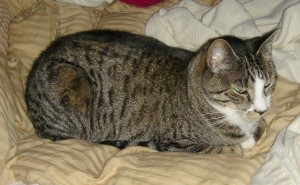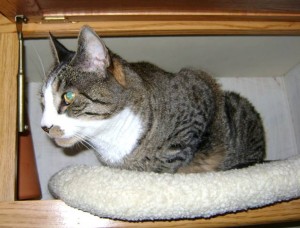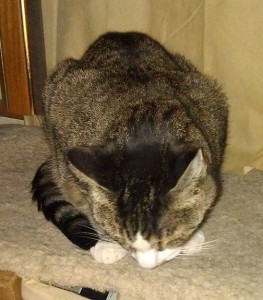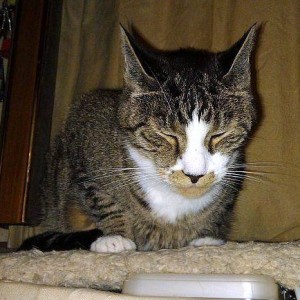By Lisa Provost
The pancreas is a very tricky organ. Because of its position in both humans and animals (behind the stomach), it’s very difficult to diagnose problems and it often disguises any inflammation viewed through X-rays, ultrasound, or even endoscopic surgery. Its two main functions include the production of metabolic hormones (insulin and glucagon which regulate blood sugar) and the production of digestive enzymes. Those enzymes are secreted through a special duct into the intestine to digest our food. In cats, the pancreatic duct joins with the common bile duct from the liver, so both bile and pancreatic fluid, which is rich in digestive enzymes enter the intestine from the same location. For this reason, ultrasound is a more accurate tool to use than X-rays and often shows an enlarged pancreas surrounded by fluid, which confirms the diagnosis. When doing ultrasound, make sure to have a board certified, licensed and experienced ultrasonographer performing the tests. They’ll know what to look for and how to spot any inconsistencies in the size and texture of the pancreas.
I highly recommend getting both an ultrasound and a Spec fPLI (pancreatic lipase) run for these reasons. Lipase is one of the pancreatic digestive enzymes with small traces that are normally present in the circulation. These levels jump dramatically in pancreatitis, giving a clear diagnosis without invasive tests. Alex’s two ultrasounds showed no inflammation in the pancreas, only the liver. But months later, her fPLI showed a positive result for pancreatitis. Another cat was the opposite. His fPLI showed no disease yet when his parent insisted on running an ultrasound, the results were positive and he was hospitalized, which saved his life. This is to say, a cat can have pancreatitis even if the fPLI doesn’t indicate it. That insistence was due in part to the sudden downturn and death of my Alex and sparked many to get their cats tested again, with both tests run. Although I lost my girl, thankfully because of her, some lives were saved. I also recommend re-testing every two to three months and staying hyper vigilant in regards to this issue. The spec fPLI is analyzed at Texas A&M labs, while at IDEXX labs it is called the spec fPL. That’s the only difference in the tests – where they are analyzed. It takes several days to a week to get results back. There is another pancreatitis test that can be run at your vet’s office, called the SNAP fPL. It’s optimized as a sensitive screening test for pancreatitis and provides immediate results, indicating whether the blood sample is above the top of the spec fPL’s normal reference range of 3.5 μg/L; it simply says yes/no to pancreatitis.
Because Alex was found to have bacterial overgrowth (SIBO/SID, see https://ibdkitties.net/sibo/) her vet has stated that she most likely died of sepsis as a result of a bacterial infection. The theory is that these bacteria are able to crawl up the pancreatic duct and cause infection in the pancreas. When the pancreas gets inflamed, the enzymes escape and begin digesting the pancreas itself. The living tissue becomes further inflamed and the tissue damage quickly involves the adjacent liver. Toxins released from this tissue destruction are released into the circulation and can cause a body-wide inflammatory response resulting in infection. For this reason, when in a pancreatic flare, digestive enzymes should only be given under the care of a veterinarian and closely monitored as it can exacerbate the digestive process. Even the vet won’t know for sure how it will affect your cat’s pancreas, but they can monitor your kitty closely and know which changes warrant either continuing the enzymes or halting their use. (This is only during a pancreatic flare or pancreatitis. Otherwise digestive enzymes can and should be given to cats daily, even healthy ones). This is also not to be confused with pancreatic enzymes which should only ever be given under a vet’s consent and supervision.
Pancreatitis can be acute or chronic. Acute cases can reverse completely but tend to be much more severe than chronic. Some signs include lethargy and/or depression, appetite loss and anorexia, abdominal pain, nausea and vomiting, weakness and unsteadiness. Rarely the cat may experience diarrhea. Pancreatitis is extremely painful and your vet should prescribe pain medications for you to administer at home along with subcutaneous fluids to avoid dehydration. Anti-emetic/anti nausea medications like Cerenia and/or pepcid is also recommended. You can also try slippery elm bark which works very well in a syrup form to help with nausea and upset stomachs. If your cat becomes anorexic, appetite stimulants should be given after the nausea and/or vomiting is under control, as the most important thing is to keep them eating. Steroid usage is under debate for pancreatitis. I’ve seen some vets give it and others who would prefer the pancreas heal itself as the liver does. Pancreatitis is a chief risk factor for developing what’s called disseminated intravascular coagulation or DIC. DIC is a massive uncoupling of normal blood clotting and clot dissolving mechanisms. This leads to simultaneous bleeding and clotting of blood throughout the body, which can eventually lead to heart failure. Plasma transfusions can sometimes be helpful to replace the clotting factors needed to prevent DIC as well as natural blood factors to deactivate pancreatic enzymes. This condition is more rare.
Symptoms of chronic pancreatitis can vary widely or be lacking entirely. Some cats require a lot of care; i.e. fluids, pain medications, anti-emetics. etc., regularly in order to manage symptoms. And some have none of the obvious symptoms. Look for things like changing color and form in their feces, and Oily, smelly stools (steatorrhea), which can also signify SIBO and EPI. Chronic pancreatitis also can lead to calcification of the pancreas, which means the pancreatic tissue hardens from deposits of insoluble calcium salts. Surgery may be necessary to remove part of the pancreas.
https://surgery.ucsf.edu/conditions–procedures/chronic-pancreatitis.aspx

This is the comfy meatloaf position that most cats lay in frequently. Legs wrapped underneath the chest area, head up, eyes relaxed, etc.

This is the “this is my spot” meatloaf position. “Found me a good place to perch”. Both very normal.

This is the nauseated meatloaf position. Head down, lip smacking, eyes squinted. This usually indicates acid reflux or feeling like they’re going to vomit.

And this is the “I’m in pain” meatloaf position. Head slightly up but hanging, eyes squinted, fur area around the eyes puffed out and swollen, crouching from cramps and abdominal pain.
Approximately 40% of cats with hepatic lipidosis have pancreatitis as the underlying cause. Hepatic lipidosis, (fatty liver disease), is liver failure that develops from appetite loss/inadequate calorie intake and complicates pancreatitis tremendously. The old recommendations that involve withholding food for 48 hours to rest the pancreas no longer apply, as there is too much risk of fatty liver disease, liver failure, infection and even death. It’s also been shown that the pancreas needs as much nutrition to heal as the liver does.
Exocrine pancreatic insufficiency (EPI, see https://ibdkitties.net/pancreatitis/epi/) is the insufficient secretion of digestive enzymes, usually due to loss of the exocrine tissue from idiopathic atrophy (unknown cause of muscle mass). It can lead to acute or chronic inflammation and causes maldigestion and malabsorption with diarrhea, steatorrhea and weight loss. Steatorrhea is excess fat in the feces due to malabsorption caused by disease of the intestines. The feces are bulky, greasy, foul smelling and pale in color. It was never diagnosed, but I now know this is what Alex had in the last week or two of her life. I thought she was going to the bathroom very well, because she never had diarrhea or constipation. But her stools became more and more pale and large, which means that she wasn’t absorbing any nutrients at all.
Alex suffered from triaditis; IBD, fatty liver disease and pancreatitis. The occurrence of these conditions are becoming more common unfortunately as when one organ is overworked, the other organs try to compensate and it’s a vicious cycle. This is why it’s incredibly important to get the inflammation down as soon as you spot trouble. Please do not wait to take your cat to the vet for an exam should they become lethargic, have chronic vomiting, inappetance, weight loss, etc. You will be taking control of the disease and doing what’s necessary to try and stop the progression. There are no guarantees that will happen but you need to at least try because once things get going, it’s hard to stop the train.
Acute pancreatitis can lead to destruction of a fair amount of pancreatic tissue. How much tissue is affected can determine what happens next. After the inflammation subsides, there is a chance of scar tissue developing in the healing process. As long as there is enough healthy tissue remaining, then your cat may never have any additional problems. http://www.allfelinehospital.com/pancreatitis.pml
Pancreatitis can cause serious complications, including:
Pseudocyst – Acute pancreatitis can cause fluid and debris to collect in cystlike pockets in your pancreas. A large pseudocyst that ruptures can cause complications such as internal bleeding and infection.
Infection – Acute pancreatitis can make your pancreas vulnerable to bacteria and infection. Pancreatic infections are serious and require intensive treatment, such as surgery to remove the infected tissue.
Kidney failure – Acute pancreatitis may cause kidney failure, which can be treated with dialysis if the kidney failure is severe and persistent.
Breathing problems – Acute pancreatitis can cause chemical changes in your body that affect your lung function, causing the level of oxygen in your blood to fall to dangerously low levels.
Diabetes – Damage to insulin-producing cells in your pancreas from chronic pancreatitis can lead to diabetes, a disease that affects the way your body uses blood sugar.
Malnutrition – Both acute and chronic pancreatitis can cause your pancreas to produce fewer of the enzymes that are needed to break down and process nutrients from the food you eat. This can lead to malnutrition, diarrhea and weight loss, even though you may be eating the same foods or the same amount of food.
Pancreatic cancer – Long-standing inflammation in your pancreas caused by chronic pancreatitis is a risk factor for developing pancreatic cancer.
https://www.mayoclinic.org/diseases-conditions/pancreatitis/symptoms-causes/syc-20360227
A recent study found that hypocalcaemia is common in cats with pancreatitis. “This study was to assess the possible effects of sex, age and breed on the evolution of pancreatitis, and to understand if low values of serum ionised calcium ([Ca(2+)i]) can be considered as a prognostic risk factor for determining the clinical course of the disease.” The results were eye opening enough to warrant frequent blood work if you’ve got a cat with chronic or acute pancreatitis.
http://www.winnfelinefoundation.org/education/cat-health-news-blog/details/cat-health-news-from-the-winn-feline-foundation/2016/02/26/serum-ionized-calcium-prognosis-and-the-clinical-course-of-pancreatitis-in-cats?utm_source=feedburner&utm_medium=email&utm_campaign=Feed%3A+CatHealthNewsFromTheWinnFelineFoundation+%28Cat+Health+News+from+the+Winn+Feline+Foundation%29
http://www.ncbi.nlm.nih.gov/pubmed/?term=Dias+C%2C+Carreira+LM
“Hypocalcemia means that the level of calcium in the bloodstream is low. Calcium is an important electrolyte within the body, and is needed for normal function of muscles and nerves. Calcium concentrations in the blood are usually regulated very closely but occasionally the control mechanism is impaired and may result in low blood calcium concentrations. Mild decreases in blood calcium concentrations will not usually result in any clinical signs, but may be detected on routine blood testing. However, if moderate to severe hypocalcemia develops, then clinical signs may occur. Early signs of hypocalcemia include restlessness, stiffness, weakness, irritability, muscle tremors and hypersensitivity (exaggerated responsiveness) to touch and sound. More profound signs include severe generalized muscle twitching, leading on to uncontrolled muscle spasms, seizures and ultimately death.”
http://www.vcahospitals.com/main/pet-health-information/article/animal-health/hypocalcemia-or-low-calcium-levels-in-cats/287
Key points in treatment of pancreatitis in felines:
1. We are now seeing many more cases of chronic versus acute pancreatitis due to inflammation present with IBD, kidney disease, liver disease, etc. It should be treated as such and unfortunately it can happen at any given time. So have an arsenal of medications, food and fluids handy for treating them at home until you can get them to the vet.
2. Keeping your cat eating should be priority number one. Fatty liver disease doesn’t take long (36-48 hours) and if that happens your kitty may need hospitalization. So syringe feeding may be neeed along with IV fluids, appetite stimulants, etc.
3. Extreme nausea and pain need to be controlled immediately in order for healing to begin and to keep your cat eating. As with liver disease, the key to healing is proper nutrition and good food. Slippery elm bark syrup, Cerenia, Zofran, Pepcid and Prilosec are some tools for nausea and vomiting.
4. Proper testing should be run; SNAP fPL or Spec fPLI (same thing, different companies), full GI panel, TLI for EPI (exocrine pancreatic insufficiency), Cobalamin (B12) for B12 deficiency, and folate levels and regular blood work, especially to check for low calcium levels.
5. Diet change is important to stop stressing the organs. A good quality protein, grain free diet, low in carbs is a good start. Commercial foods can have A LOT of nasty ingredients so a raw or home cooked diet is best. Wet food is better than dry any day. It’s not always possible to get them to switch but it should be tried as kibble is terrible for them and does their organs no good. The old school thinking was to restrict fat for a cat but they are not like dogs and the chances of a higher fat diet triggering pancreatitis are very low if at all.
6. Stress has a terrible effect on cats with these conditions and should be kept to a minimum if at all possible. Using Feliway diffussers, calming collars, Bach Alcohol Free Rescue Remedy, Alcohol free flower essences, etc. should help.
Learning the signs of distress from your cat can help to facilitate that early treatment. Pacing around the room, crying, huddling and rapid breathing. Putting what’s called their third eyelid up, the coated film on their eyes beginning to close. Those are signs of extreme pain and disorientation. Fever, accompanied by a quick temperature drop are usually a sign that organ failure has started and the body is shutting down. Get your cat to a vet or an ER immediately if they exhibit any of these signs. Cats are the smartest animals at hiding their illnesses and are notorious for not showing any symptoms at all, even if they’re very sick, until it’s almost too late. This is their natural defense mechanism for surviving in the wild. Learning to recognize different behavior patterns and any changes in their diet, stools, coloring, etc. is the best way to tell if they need to be seen by a vet. Please see Alex’s medical history page for more information:
https://ibdkitties.net/case-studies-4/alex-p/
Some materials used in this article were written and provided by:
Dr. Wendy C. Brooks, DVM, DipABVP
IDEXX Laboratories Introduces the SNAP® fPL™ Test
http://www.idexx.es/pdf/es_es/smallanimal/snap/fpl/idexx-introduces-snap-fpl.pdf
References & Resources:
https://www.idexx.com/files/small-animal-health/products-and-services/reference-laboratories/spec-fpl-treatment-for-feline-pancreatitis.pdf
www.ncbi.nlm.nih.gov/pmc/articles/PMC1111363/
www.felineoutreach.org/Education/Pancreas.html
www.vin.com/proceedings/Proceedings.plx?CID=WALTHAMTNAVC2003&PID=3670
http://www.cuvs.org/pdf/AdvancesinInternalMedicineDiagnosticTesting.pdf
http://www.merckvetmanual.com/mvm/digestive_system/the_exocrine_pancreas/pancreatitis_in_small_animals.html?qt=Feline+pancreatitis&alt=sh
http://www.2ndchance.info/pancreatitiscat.htm
http://www.2ndchance.info/pancreatitisdogXenoulis2008.pdf
https://www.vetinfo.com/cpancrea.html
